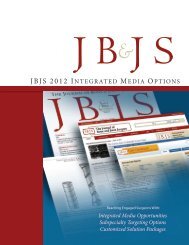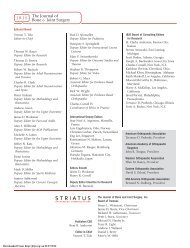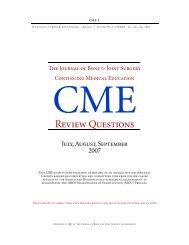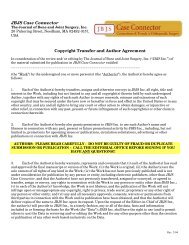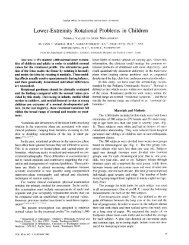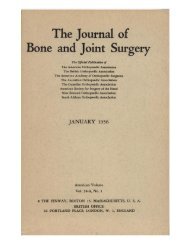Front Matter - The Journal of Bone & Joint Surgery
Front Matter - The Journal of Bone & Joint Surgery
Front Matter - The Journal of Bone & Joint Surgery
Create successful ePaper yourself
Turn your PDF publications into a flip-book with our unique Google optimized e-Paper software.
Adv 32<br />
JBJS [Br] Abstracts Now Available<br />
Hip<br />
Reduction <strong>of</strong> the potential for thermal damage during hip resurfacing<br />
H. S. Gill, P. A. Campbell, D. W. Murray, and K. A. De Smet<br />
J <strong>Bone</strong> <strong>Joint</strong> Surg Br 2007 89-B: 16-20<br />
Resurfacing arthroplasty <strong>of</strong> the hip is being used increasingly<br />
as an alternative to total hip replacement, especially for young<br />
active patients. <strong>The</strong>re is concern about necrosis <strong>of</strong> the femoral<br />
head after resurfacing which can result in fracture and loosening.<br />
Most systems use a cemented femoral component, with<br />
the potential for thermal necrosis <strong>of</strong> the cancellous bone <strong>of</strong> the<br />
reamed femoral head. We used thermal probes to record temperatures<br />
close to the cement-bone interface during resurfacing<br />
arthroplasty.<br />
<strong>The</strong> maximum temperature recorded at the cement-bone<br />
interface in four cases was approximately 68°C which was<br />
higher than that reported to kill osteocytes. A modified surgical<br />
technique using insertion <strong>of</strong> a suction cannula into the lesser<br />
trochanter, generous pulsed lavage and early reduction <strong>of</strong> the<br />
joint significantly reduced the maximum recorded cancellous<br />
bone temperature to approximately 36°C in five cases (p =<br />
0.014).<br />
We recommend the modified technique since it significantly<br />
reduces temperatures at the cement-bone interface.<br />
Trauma<br />
Conservative treatment <strong>of</strong> isolated fractures <strong>of</strong> the medial malleolus<br />
D. Herscovici, Jr, J. M. Scaduto, and A. Infante<br />
J <strong>Bone</strong> <strong>Joint</strong> Surg Br 2007 89-B: 89-93<br />
Between 1992 and 2000, 57 patients with 57 isolated fractures<br />
<strong>of</strong> the medial malleolus were treated conservatively by<br />
immobilisation in a cast. <strong>The</strong> results were assessed by examination,<br />
radiography and completion <strong>of</strong> the short form-36 questionnaire<br />
and American Orthopaedic Foot and Ankle Society<br />
ankle-hindfoot score.<br />
Of the 57 fractures 55 healed without further treatment.<br />
<strong>The</strong> mean combined dorsi- and plantar flexion was 52.3° (25°<br />
to 82°) and the mean short form-36 and American Orthopaedic<br />
Foot and Ankle Society scores 48.1 (28 to 60) and 89.8 (69 to<br />
100), respectively. At review there was no evidence <strong>of</strong> medial<br />
instability, dermatological complications, malalignment <strong>of</strong> the<br />
mortise or <strong>of</strong> post-traumatic arthritis.<br />
Isolated fractures <strong>of</strong> the medial malleolus can obtain high<br />
rates <strong>of</strong> union and good functional results with conservative<br />
treatment. Operation should be reserved for bi- or trimalleolar<br />
fractures, open fractures, injuries which compromise the skin or<br />
those involving the plafond or for patients who develop painful<br />
nonunion.<br />
Knee<br />
Validation <strong>of</strong> the short-form WOMAC function scale for the evaluation<br />
<strong>of</strong> osteoarthritis <strong>of</strong> the knee<br />
K. G. Auw Yang, N. J. H. Raijmakers, A. J. Verbout, W. J. A. Dhert, and<br />
D. B. F. Saris<br />
J <strong>Bone</strong> <strong>Joint</strong> Surg Br 2007 89-B: 50-56<br />
This study validates the short-form WOMAC function<br />
scale for assessment <strong>of</strong> conservative treatment <strong>of</strong> osteoarthritis<br />
<strong>of</strong> the knee. Data were collected before treatment and six and<br />
nine months later, from 100 patients with osteoarthritis <strong>of</strong> the<br />
knee to determine the validity, internal consistency, test-retest<br />
reliability, floor and ceiling effects, and responsiveness <strong>of</strong> the<br />
short-form WOMAC function scale. <strong>The</strong> scale showed high correlation<br />
with the traditional WOMAC and other measures. <strong>The</strong><br />
internal consistency was good (Cronbach : 0.88 to 0.95) and an<br />
excellent test-retest reliability was found (Lin’s concordance correlation<br />
coefficient ( c): 0.85 to 0.94). <strong>The</strong> responsiveness was<br />
adequate and comparable to that <strong>of</strong> the traditional WOMAC<br />
(standardised response mean 0.56 to 0.44 and effect size 0.64 to<br />
0.57) and appeared not to be significantly affected by floor or<br />
ceiling effects (0% and 7%, respectively).<br />
<strong>The</strong> short-form WOMAC function scale is a valid, reliable<br />
and responsive alternative to the traditional WOMAC in the<br />
evaluation <strong>of</strong> patients with osteoarthritis <strong>of</strong> the knee managed<br />
conservatively. It is simple to use in daily practice and is therefore<br />
less <strong>of</strong> a burden for patients in clinical trials.<br />
Downloaded From: http://jbjs.org/ on 01/27/2014<br />
THE JOURNAL OF<br />
BONE AND JOINT SURGERY<br />
www.jbjs.org.uk



